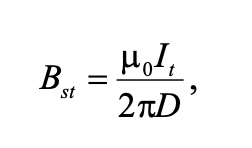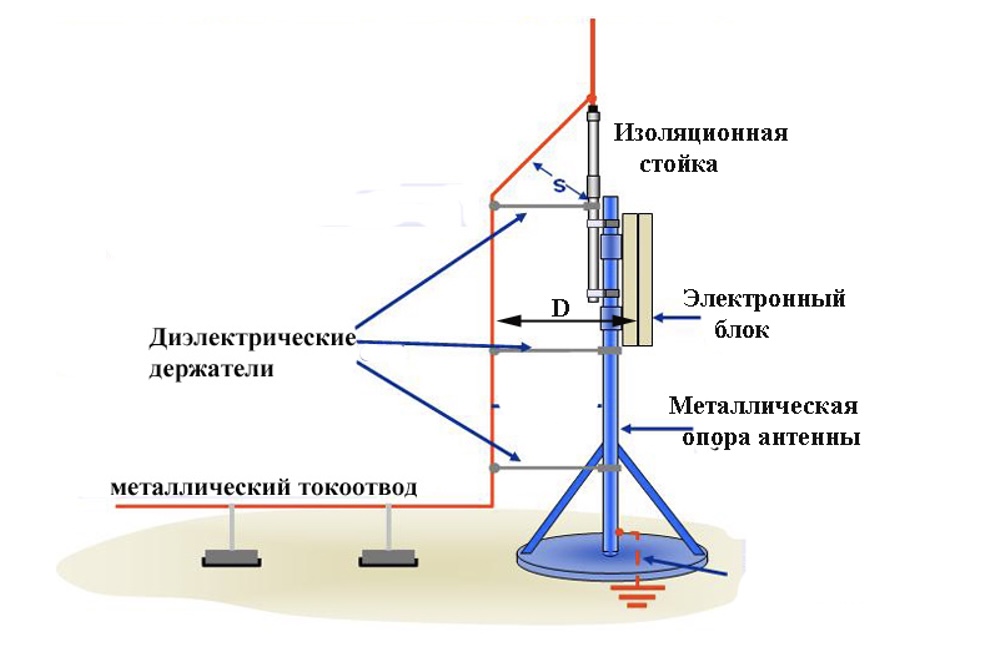
E. M. Bazelyan, DEA, professor;
Power Engineering Institute to the name of G.M. Krzhizhanovsky , Moscow;
recognized Russian expert in the field of grounding and lightning protection.
To explain the principle of operation of an isolated lightning protection, the antenna system is usually demonstrated with the electronic unit installed on its support. It receives a valid signal or, vice versa, emits the electromagnetic pulse bearing a control command. The electronic unit requires protection against lightning current which, upon the strike into the antenna mast, distributes along its metal structures nearby and sets up a strong magnetic field. In the simplest and the worst case of a single current collector, the magnetic field induction is determined in the following way:

where D is the distance from the current collector to the electronic unit, and It is the current in the current collector. Two electromagnetic interference suppression ways follow from this formula. To do this, you should either increase the distance to the current collector or reduce a fraction of the lightning current in the current collector Isolated lightning protection implies choosing the first option. Its lightning arrester is isolated from the antenna mast, and the current collector is spaced to the maximum possible distance, D, from the protected unit, since the magnetic field is inversely proportional to this parameter.

Изоляционная стойка - Isolating standard
Диэлектрические держатели - Dielectric holders
Электронный блок - Electronic unit
Металлический токоотвод - Metal current collector
Металлическая опора антенны - Metal antenna support
The effect is restricted by the length of dielectric holders. In real-life structures, it is within one meter. We should make a remark for isolated current collectors. Isolation and a semiconductor layer applied onto the surface of such current collectors are not shields and they do not weaken the magnetic field of the lightning current. In this regard, their use does not provide any advantages.
Now, let's talk about an alternative option. It requires transferring the current among as many current collectors as possible. This is possible in practice if their role is played by a metal structure of the antenna mast. Let's assume that the protected electronic unit is secured to it. Then, the distance from the conductor with the lightning current to the elements of the electronics, D , will be determined by the unit enclosure thickness and its securing elements. It will hardly exceed several centimeters. To provide a qualitative estimate, let's assume that, e.g., D = d = 5 cm. Then, to provide competition with isolated lightning protection, the lightning current in the current collector should be weakened at least D/d times. To provide isolated lightning protection with D cm, we should talk about approx. 100/5 = 20 current collectors. Such a complex antenna mast can hardly be real. The effect of this multiple division of the lightning current in real life is possible only in the location of an electronic unit on a reinforced concrete or metal wall as well as reinforced concrete supports with 1 m diameter where the role of a large number of current collectors is played by the metal reinforcement. This situation can hardly have a practical meaning.
However, a negative designer's attitude to the use of the isolated lightning protection can be explained. And the point is not in the increased cost of its installation but in a significantly lower mechanical strength which is particularly important for the Russian regions with high wind and ice loads. If there are doubts, it is hardly worth looking for any antenna support with a large number of parallel metal structures. It is easier and cheaper to use the protection for electronic units using SDPs. Looks like it should be installed anyway since the electronic unit will likely be electrically coupled with the antenna located on the mast and can be exposed to the direct exposure of the lightning current.
Related Articles:
 Lightning Protection of Large Territories: Parks, Grounds, Plant Territories. Page 1
Lightning Protection of Large Territories: Parks, Grounds, Plant Territories. Page 1
 Lightning Protection of Large Territories: Parks, Grounds, Plant Territories. Page 2
Lightning Protection of Large Territories: Parks, Grounds, Plant Territories. Page 2
 Lightning Protection of Large Territories: Parks, Grounds, Plant Territories. Page 3
Lightning Protection of Large Territories: Parks, Grounds, Plant Territories. Page 3

